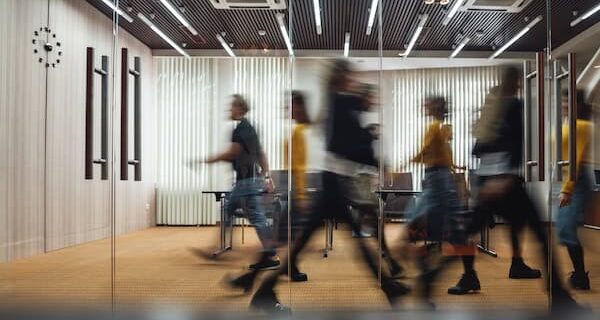Why Traditional Office Security Is Missing The Mark In The Digital Age

Facility management professionals across industries know that safeguarding physical premises is essential. Yet, as workplaces evolve with hybrid schedules, connected devices, and mobile work, many long-standing security practices fall short. Traditional office security assumes threats are mostly external and physical, but today’s risks cross the physical-digital divide. Successful security requires an integrated approach.
The Limits Of Traditional Physical Security
Conventional measures such as locks, alarms, access cards and on-site guards remain vital, but they were designed for a different era. Keys can be cloned, employees can be followed through doors in moments of distraction and fixed barriers rarely account for the flexibility modern facilities demand. Security staff may be vigilant, but their reach is limited when suspicious activity occurs far from their sight line.
An early example of physical security evolving to meet new needs came in the mid-19th century, when the U.S. introduced the modern metal security grille, also called a mall grille, to businesses and retail spaces. It offered a way to balance visibility, airflow, and deterrence. While today’s versions remain durable and low-maintenance, mechanical barriers alone cannot keep pace with blended threats that span both the physical and digital landscapes.
Gaps Between Physical & Digital Security
For many organizations, physical security and cybersecurity are managed in separate silos. In practice, the two are inseparable. A person who gains unauthorized entry to an office can use an unattended computer to plant malicious software, turning a physical breach into a digital compromise. Likewise, a poorly secured personal laptop brought into the building can connect to the company network and introduce vulnerabilities.
Even building systems such as smart locks and connected cameras, once designed solely for physical control, are now part of the corporate network and susceptible to hacking. Patterns of daily activity also play a role in vulnerability.
Just as most burglaries at home occur during daytime hours when occupants are away, offices have their own blind spots, such as lunch breaks, hybrid schedules with lighter foot traffic or offsite company events. When employees share these routines publicly on social media, they unintentionally signal windows of opportunity to intruders, increasing physical and digital risks. This crossover underscores the need for convergence, aligning both safeguards under one strategy rather than treating them as parallel but disconnected concerns.
Why Traditional Cybersecurity Falls Short, Too
Just as older physical tools no longer stand alone, legacy cybersecurity methods struggle in modern environments. Firewalls and signature-based antivirus software were developed when networks were closed and predictable.
Today, threats constantly evolve, with attackers using advanced techniques that bypass static defenses. Social engineering adds another layer of complexity, as employees remain a common entry point for attackers. A single well-crafted phishing message or impersonation attempt can undermine entire systems.
Remote work and cloud adoption add to the challenge by dissolving the traditional office perimeter. The old castle-and-moat approach—built on the idea that threats would come from the outside and everything inside the walls could be trusted—no longer works. As a result, entities that continue relying solely on legacy tools leave significant blind spots.
How Facility Managers Can Upgrade Security For The Digital Age
Modern threats call for modern responses, and facility managers are uniquely positioned to align physical and digital security. The key is to move from a patchwork of measures to an integrated model that anticipates how risks overlap.
- Integrating physical & cybersecurity: A unified approach allows facility managers, IT teams, and security personnel to work from the same playbook. When access controls, camera systems, and network monitoring are viewed together, potential threats are easier to detect and address quickly.
- Modernizing physical barriers: Physical barriers remain vital, but they are most effective when updated to meet today’s standards. Rolling security grilles with advanced design provide visibility and airflow while maintaining robust deterrence. These measures deliver strength and adaptability, combined with access controls that log unusual activity.
- Elevating digital protections: Beyond traditional antivirus, tools such as endpoint detection, behavioral analytics, and zero-trust architecture are now essential. Zero trust assumes no user or device is automatically trusted, requiring verification every time. This model helps contain threats even when attackers manage to gain access.
- Building a unified incident-response plan: When physical and digital defenses converge, response plans must do the same. An incident that begins with tailgating might lead to a digital compromise, and a suspected phishing attempt might be tied to a physical intrusion. Cross-functional drills and shared playbooks ensure nothing slips through the cracks.
Benefits Of A Converged, Modern Security Model
Upgrading office security to meet today’s demands is not only about reducing risk. A converged approach also delivers practical advantages for facility management:
- Stronger deterrence: Modern barriers and remote monitoring make it harder for intruders to succeed and often discourage attempts altogether.
- Greater visibility: By combining access logs, surveillance feeds, and network data into a unified view, blind spots are reduced and anomalies are easier to identify.
- Faster response: When alerts from physical and digital sources are linked, teams can respond more quickly and effectively, thereby shortening the exposure window.
- Long-term efficiency: Durable hardware paired with automated monitoring reduces reliance on round-the-clock on-site staff, ultimately lowering costs over time.
- Resilience for hybrid work: Whether staff are in the office or remote, converged systems and zero-trust controls maintain consistent protection across environments.
Securing The Office Of The Future
Traditional office security—whether physical locks or antivirus software—was built for challenges of the past. In the digital age, facility managers must champion an integrated model that blends modern physical barriers, intelligent monitoring, and advanced digital safeguards.
By Evelyn Long
Evelyn Long is a writer with expertise in commercial interior design, driven by a passion for creating accessible and comfortable office, hotel, and other public spaces. As a regular contributor to publications like I+S and the National Association of Realtors, she shares her insights on creating inclusive and functional environments. Long also serves as the Editor-in-Chief of Renovated Magazine, where she champions innovative design solutions for the modern world.

